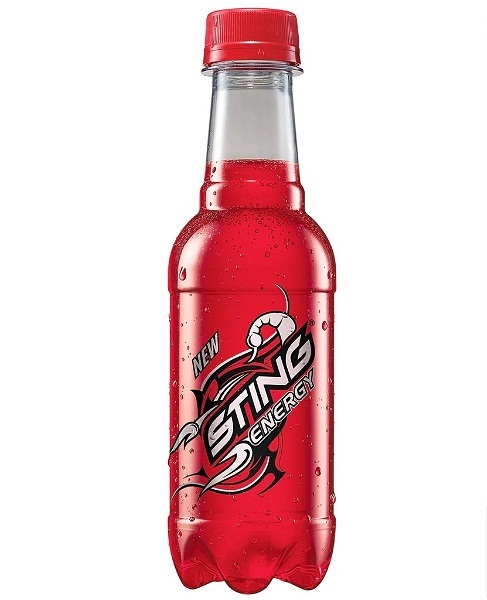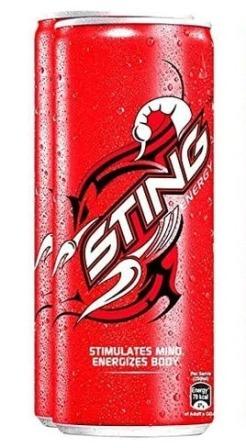How Many Calories in Sting 250ml: If you are a big fan of Sting drink and want to know how many calories are in Sting Energy drink 250ml bottle, then you are at the right place. In this article, we are discussing calories and the percentage of calories in a Sting 250ml bottle. Read the full article for complete information.
How Many Calories in Sting 250ml Bottle
As per research by various health organizations on the Sting energy drink, it is found that per serving of 250ml Sting total of 70 calories (kcal) is present. Let’s understand about Calories present in energy drinks.
Read Also: Sting Energy Drink Ingredients in Details
Understand Calories
The outdated caloric theory of heat gave rise to the calorie, a unit of energy. For authentic reasons, two primary meanings of “calorie” are in wide use. The enormous calorie, food calorie, dietary calorie, or kilogram calorie was initially characterized as a need that might have arisen to raise the temperature of one kilogram of water by one degree Celsius (or one kelvin).
The little calorie or gram calories were characterized as the need that might have arisen to cause a similar expansion in one gram of water. In this way, 1 enormous calorie is equivalent to 1000 little calories.

In sustenance and food science, the expression “calorie” and the image “cal” can allude to either the huge or little unit, contingent upon where you are on the planet. It is by and large utilized in distributions and bundle names to communicate the energy worth of food varieties per serving or per weight, suggested dietary caloric intake, metabolic rates, and so on.
A few creators suggest the spelling Calorie and the image Cal (both with a capital C) in the event that the huge calorie is implied, to stay away from confusion; however, this show is frequently disregarded.
In material science and science, the word calories and its image for the most part allude to the little unit; the enormous one being called kilo calorie. In any case, this unit isn’t formally essential for the decimal measuring standard (SI) and is viewed as out of date, having been supplanted for many purposes by the SI unit of energy, the joule (J).
The “little” calorie is extensively characterized as a need might have arisen to build the temperature of 1 gram of water by 1 °C (or 1 K, which is a similar addition, a degree of one percent of the stretch between the softening point and the limit of water).
The genuine measure of energy expected to achieve this temperature increment relies upon the air pressure and the beginning temperature; various decisions of these boundaries have brought about a few different exact meanings of the unit.
Caloric admission control, and decrease for overweight people, is suggested by US dietary rules and science-based social orders.
Calories limitation is suggested for individuals with diabetes and pre-diabetes, in blend with actual activity and a weight reduction objective of 5-15% for diabetes and 7-10% for pre-diabetes to forestall movement to diabetes. Gentle calorie limitation might be helpful for pregnant ladies to diminish weight gain (without weight reduction) and lessen perinatal dangers for both the mother and the youngster.
For overweight or corpulent people, calorie limitation might further develop well-being through weight reduction, albeit a steady weight recapture of 1-2 kg (2.2-4.4 lb) each year might happen.

The expression “calorie limitation” as utilized in the investigation of maturing alludes to dietary regimens that diminish calorie admission without bringing about hunger. According to the findings of the Minnesota Starvation Experiment, malnutrition can have serious negative effects if essential nutrients are not included in a restricted diet. During World War II, a group of lean men participated in this study.
For six months, they consumed fewer calories by 45% and consumed approximately 77% carbohydrates. True to form, this ailing health brought about metabolic transformations, for example, diminished muscle-to-fat ratio, further developed lipid profile, and diminished resting pulse. Anemia, edema, muscle wasting, weakness, dizziness, irritability, lethargy, and depression were also effects of the experiment.
To fully comprehend the connections between single nutrient modifications, calorie restriction, and regular exercise in the prevention of cardiovascular disease, cancer, cognitive deficit, inflammatory diseases, sarcopenia, and immune senescence, additional research on humans and experimental animals is required.
Starting around 2021, there is an absence of sufficiently controlled long-haul studies looking at the effect of calorie limitation on people. In spite of the fact that calorie limitation enjoys the benefit of dialing back the decrease of bulk with age, the underlying decrease of mass might be significant and meaningfully affect an individual’s solidarity and perseverance.

Restrictions of Calories
While still meeting nutrient needs, cutting calories by 20 to 30 percent has been shown to treat aging-related diseases like cancer, cardiovascular disease, dementia, and diabetes in humans and lead to an average weight loss of 7.9 kilograms (17 lb).
However, due to the long lifespan of humans, there is no evidence that cutting calories could prevent age-related diseases in humans. While calorie limitation prompts weight and fat misfortune, the exact measure of calorie consumption and related fat mass for ideal well-being in people isn’t known. Moderate measures of calorie limitation might hurtfully affect specific populace gatherings, for example, lean individuals with a low muscle-to-fat ratio.
Calories limitation jelly muscle tissue in nonhuman primates and rodents. Muscle tissue grows when it is stimulated, so it has been hypothesized that the test animals that were restricted in calories exercised more than their companions who were given more calories. This could be because animals go into a foraging state when they are restricted in calories. However, studies indicate that in youth, overall activity levels are comparable to those of ad libitum animals regardless of calorie restriction.
